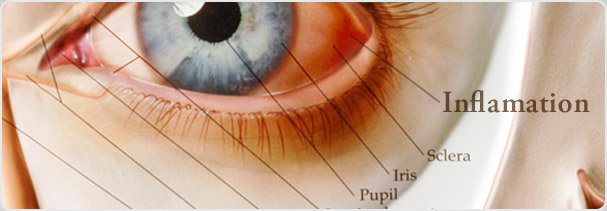Eye Inflammation or Uveitis
The eye inflammation of uveitis can become a serious problem if left untreated. To prevent glaucoma, cataracts or even blindness, prompt assessment by a doctor is needed.
The eye can be thought of as a ball made from three layers of tissue – a tough, protective outer layer, the inner retina, and a middle layer called the uvea. It is in the uvea that uveitis occurs.
Types of Eye Inflammation in Uveitis
“Uveitis” simply means inflammation of the uvea, though the term is often used to describe inflammation anywhere inside the eye. The uvea includes the iris (the coloured part of the eye), the muscles behind the iris that control the size of the pupil, and the tissue at the back of the eye that supports the retina. Any or all of these areas may be affected in uveitis.
- The most common problem is anterior uveitis, in which the iris becomes inflamed.
- Intermediate uveitis is inflammation of the middle part of the uvea.
- In posterior uveitis, the uvea at the back of the eye is affected.
The symptoms of uveitis include a reddened eye, blurred vision, pain in the eye, floating spots in the field of vision (“floaters”) and sensitivity to light.
Causes of Eye Inflammation
Uveitis is often an autoimmune eye problem, in which the body’s tissues are attacked by its own immune system. It may occur in people with another autoimmune condition such as Crohn’s disease, psoriasis or ankylosing spondylitis.
In other cases, the inflammation is a normal immune response to an infection inside the eye. Infections that may cause uveitis include herpes, shingles, Lyme disease, tuberculosis and toxoplasmosis.
An injury to the eye, such as a blow to the iris, can also lead to uveitis.
Treatment of Eye Inflammation in Uveitis
As with other types of eye problems, it is important to get a doctor’s opinion on an inflamed eye. Uveitis can develop serious complications if left untreated, leading to glaucoma, cataracts, detached retina or even blindness. The doctor will examine the inside of the eye using a special instrument called a slit lamp, and may order other investigations such as blood tests and X-rays.
Treatments for uveitis depend on the severity of the problem and the part of the eye that is affected. It is important to start treatment as soon as possible.
- People with anterior uveitis are commonly prescribed steroid eye drops to reduce the inflammation of the iris, along with mydriatic eye drops to dilate the pupil and reduce pain. Wearing dark glasses may also be helpful.
- Steroid tablets or steroid injections into the eye may be needed in severe cases.
- In some patients, immunosuppressant drugs, which suppress the immune system, are also required.
- When uveitis is caused by an infection, treatment appropriate for that infection (e.g. antibiotics) is given.
Recovery from Uveitis
In most cases, uveitis clears up within a few days to weeks, depending on the cause and severity. Posterior uveitis is more difficult to treat; it may last months or years, and even with treatment the eye damage may be permanent. All types of uveitis can recur, so it is important to consult a doctor whenever suspicious symptoms arise.
References:
MedlinePlus. Uveitis. https://medlineplus.gov/ency/article/001005.htm Accessed 06-04-17
Royal National Institute of Blind People. Uveitis. http://www.rnib.org.uk/eye-health-eye-conditions-z-eye-conditions/uveitis Accessed 06-04-17
